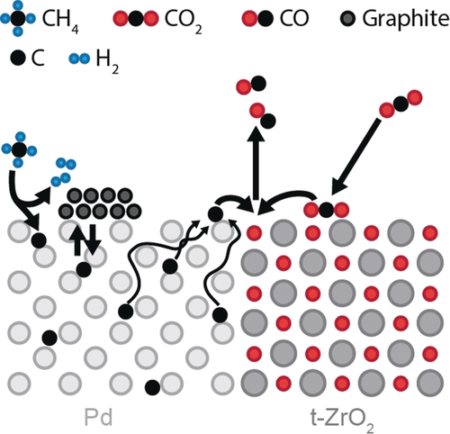The accumulation of greenhouse gases, like methane and carbon dioxide, traps heat in Earth’s atmosphere and causes the rising global temperatures associated with climate change. In searching for ways to reduce greenhouse gases and stem the effects of climate change, scientists proposed dry reforming, a process that converts methane and carbon dioxide into synthesis gas (syngas). Dry reforming is an attractive solution because it simultaneously decreases harm (greenhouse gas abatement) and provides utility (alternative fuel production). However, dry reforming processes have been stymied by inefficient catalysts. Now, a group from the University of Innsbruck has found a route to efficiently activate the nonreactive carbon from methane and carbon dioxide.
Using x-ray diffraction at ALS Beamline 12.2.2 and in situ x-ray photoelectron spectroscopy at BESSY II in Berlin, the researchers investigated different combinations of palladium and zirconium in catalyzing the dry reforming process. The synchrotron radiation experiments allowed them to visualize the behavior of carbon during the conversion process, and the researchers found that carbon dissolves well in palladium during the dry reforming process. The carbon dissolved in palladium then diffuses to the palladium/zirconium interface and converts efficiently into the desired syngas, a mixture of carbon monoxide and hydrogen.
While dry reforming has been studied in the past, catalysts were optimized for converting either methane or carbon dioxide. These results demonstrate a means of converting both gases using the same optimized catalyst. The information offers a useful application of palladium/zirconium catalysts in reducing the harmful effects of greenhouse gases, an urgent need in the face of climate change.

N. Köpfle, T. Götsch, M. Grünbacher, E.A. Carbonio, M. Hävecker, A. Knop-Gericke, L. Schlicker, A. Doran, D. Kober, A. Gurlo, S. Penner, and B. Klötzer, “Zirconium-assisted activation of palladium to boost syngas production by methane dry reforming,”Angew. Chem. Int. Ed. 57, 44 (2018), doi:10.1002/anie.201807463.